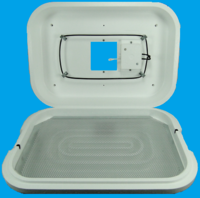Bellsouth Poultry Equipment Poultry Information FAQ Bellsouth Incubators
FAQ Bellsouth 100 Egg Incubators

B100 helpful hints
HELP! I lost my B100 Incubator instruction booklet. Select here for Bellsouth 100 Instructions PDF
What is a manual turn Egg incubator? With the Bellsouth 100 Semi Auto Incubator this means opening the lid and hand turning each egg on the perforated mesh floor.
What is a semi automatic incubator? With the Bellsouth 100 egg incubator, a semi automatic has a push/pull rod on the outside so the lid of the incubator does not need to be opened and retains heat and humidity .
Can I buy a Bellsouth 100 manual turn and upgrade it to semi automatic or fully automatic?
Yes, you can upgrade from the manual to semi automatic turning, or from the manual to fully automatic turning incubator, and the semi automatic to fully automatic turning incubator.
Should I place the incubator on a piece of carpet or a towel because the bench seems cold?
Definitely not, a fluffy towel will block up the air holes in the incubator and so the air flow will be disrupted and incubation will be difficult
Should I place a towel over the incubator so it keeps its temperature in the winter?
No, again it blocks up the air holes in the incubator so the ventilation will not work correctly. The incubator should only be used in the range of room temperature between 15 and 30 degrees C. It will not operate correctly outside this range. Drafts in a room can also make a room act colder than it is, so dont place the incubator on the floor, or in a draught.
Can I mix up 2 different eggs in the incubator? I have heard you can do it in some incubators.
In still air incubators we set the temperature at the top of the egg to bird body temperature, basically 103 degrees Fahrenheit. The incubator has a thermal gradient, which is a neat way of saying its hotter up higher and cooler down lower. So if I put a big egg in and I have set it for an average egg the top of the big egg is higher, and so the egg is hotter. Alternatively the small egg is lower than the average so the temperature for that egg is lower. In a forced draft incubator all the temperatures are the same, but the humidity cannot be adjusted for the differences needed between egg species so it is a compromise with any incubator to mix egg species.
There is no fan in the Bellsouth 100 Egg incubator. I have read on the internet polystyrene incubators need a fan?
A fan is required in some cheap incubators as they do not have electronic thermostats. With a mechanical thermostat, the control is situated high above the eggs. When the temperature is set, it will be subject to changes in the room temperature.
The thermostat can only regulate where it is, which is not where the eggs are. As a result, a change in room temp changes the thermal gradient in the incubator and so the egg temperature.
The mechanical thermostats are also subject to air pressure changes which will cause the incubator temperature to go up when the air pressure goes up and down when the air temperature goes down.
electronic thermostat in the Bellsouth 100 is not effected by air pressure and so does not react to it, and because the sensor is level with the top of the eggs, will accurately maintain the temperature at the top of the eggs, negating any effect of changes of room temperature within the 15-30 degree range. So no fan is needed, indeed there is no fan under a broody hen. A fan is needed in multi level incubators.
Does a chook have a fan? In a still air incubator, the air higher in the incubator is warmer than at the bottom, just like the hen in the natural nest. But the gradient of that air is determined by outside air temperature. If the outside air temp is low then the difference between the temperature at the bottom of the incubator ( outside air temperature) and the thermostat is greater. Likewise if the temp in the room increases, then the thermal gradient declines.
Now if the thermostat is a long way from the egg, it holds the temperature WHERE IT IS at the constant temperature. But in that design, the temperature where the egg is varies all over the place. A partial fix is to put in a fan which theoretically makes everywhere in the incubator the same, but creates other problems. However if by using electronics and a moveable spot sensor probe, and having the point the temperature is measured at the top of the egg, the thermostat now controls the temperature on the top of the egg, just like the broody bird does, suddenly the still air works like a charm. If the room varies ( within the limits of most machines, between say 15 degrees and 30 degrees, the top of the egg temp stays the same.
So the most natural incubation is that of a still air machine. Granted we have some other limitations, one egg size in the incubator at a time, you must move the height of the probe of the thermostat and the height of the thermometer to level with the top of the egg for each different egg size, and still air incubators have very distinct size limitations, namely only one tray level.



